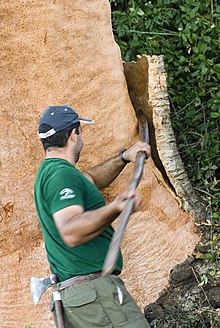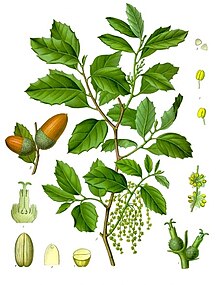Quercus suber
The cork oak (Quercus suber) is a medium-sized, evergreen tree native to Europe and North Africa. Anthropically widespread due to the exploitation of its bark from which cork is obtained. The cork oak is also known in some regions, especially the young specimens, such as chaparro or sombrero oak.
It has a thick, rough rind. Over time, the bark reaches a considerable thickness, and it can be collected from 9 (Cádiz) to 14 (Sierra de Espadán) years, depending on the quality of the season in which cork is found, especially due to the quantity and annual distribution of rainfall.[citation required] The quality of cork is proportional to the number of years it takes to produce. The optimum collection thickness is marked by the diameter of the stoppers, since it is the product obtained from the cork with the highest added value. A standard stopper is 24mm, so an optimal cork thickness would be around 30mm. Harvesting the cork does not harm the tree, since it can produce a new layer again, being a renewable resource. The tree is widely cultivated in Spain, Portugal, Algeria, Morocco, France, Italy, and Tunisia. Cork oak forests cover an area of 2.5 million hectares in these countries. Portugal has 50% of world production, and in this country logging is prohibited except for forest management or for old and unproductive trees.
They live between 150 and 250 years although there are cork oaks dating back more than five hundred years such as the "Bosco di San Pietro" in Caltagirone, Sicily, Italy, which is estimated to have been planted in the year 1400. Bornizo cork is obtained in the first harvest, which is done when the tree reaches 30-50 years of age. Thereafter it can be collected every 9-14 years. Cork harvesting is completely manual.
The European cork industry produces 340,000 tons of cork per year, worth €250 million [citation needed] (at an average value of 70 euro cents per kilo of cork), and employs 30,000 people (with an excellent ratio of one job created for every 7,900 euros of cork). Wine stoppers represent 15% of cork use by weight, but represent 80% of the business.
Etymology
The scientific name Quercus suber derives from the Latin word quercus, which was used by the Romans to describe the common oak (Quercus robur). The specific epithet suber in Latin means cork or hat, which is why the tree is also known as sombrero.
Ecology
The Quercus suber is one of the components of the Mediterranean forest. It needs more humidity and supports less cold and nothing lime compared to the oak that replaces it when these three conditions are not met, together, and to a large extent it happens as the climate becomes continental. One of the reasons is that the Quercus suber acorns are produced in the months of September (Migueleñas) until January, when frosts are much more frequent. The cork seems to be the result of the evolution of the species for protection against fire, common in this climate with such dry summers.
Its economic interest allows the conservation of extensive forest areas there in the countries where it lives, as well as its sustainable development. The acorn is used by a wide variety of animals for food, from non-migratory to cranes in winter. In the Doñana National Park, the area of highest ecological value, known as Las Pajareras, is a formation of gigantic cork oaks scattered on the border of the mountain with the marsh.
Cork
Extraction
The extraction of cork is a highly specialized task. This is done every 9-14 years, depending on the production and destination of the cork. In the first extraction, at 30-40 years of age, a lower quality cork called "bornizo" is extracted. This cork is the original bark of the tree, which, due to the increase in circumference from the initial stem to the mature trunk, presents deep cracks that prevent the removal of regular planks. This is the cork that is used in many places as an ornament in nativity scenes, simulating rocks or mountains.
Once the trim is removed, the following "panas" (freshly extracted cork sheets) have a more regular appearance, as the relative increase in the circumference of the tree is much smaller.
The extraction of the cork is a delicate process, in which it is necessary to avoid damaging the "mother" of the cork, the living layer from which it is generated (phellogen). The presence of insects (cork shingles, Coraebus undatus) or damage from drought or defoliators can weaken this layer and make it easily damaged during extraction, compromising the quality of future extractions. The experience of the technician to be able to recognize these situations and in any case to carry out the extraction without damaging the "mother" It's fundamental.
An important part of the cork industry resides in Spain (especially in Andalusia and southern Extremadura), where around 30% of world production is produced.
Uses of cork
Among the various uses of cork, we can highlight that it is mainly used to seal bottles of alcoholic beverages such as wines, spirits and cavas or champagne (whites, reds, rosés, stills, sparkling, etc.), for which it is They carry out meticulous quality tests. Then, once the loads suitable for use have been selected, those that are deficient and the remaining cork material (which could not be used due to the type of cut applied to the bark) are sent to a recycling center, where it is crushed everything and sheets of the so-called "cork agglomerate" are formed, through different processes. The resulting agglomerate is used in the lining of satellite capsules (5 to 6 mm thick), in the lining of floors (there is a wide range of cork flooring) and walls (cork sheets or paper) or in the manufacture of templates for footwear and clothing. Cork agglomerate has various properties, such as its resistance to fire, its partial absorption of humidity (between 10% and 12%) and thermal insulation.
Another important use of this natural material, and one that is becoming increasingly popular, is for construction as an acoustic and thermal insulation material. Natural cork is also used to seal engine joints and in an artisan way, either to make decorative items such as trays, clocks, paintings, frames, models, nativity scenes portals and other similar decorations.
Other uses of Quercus suber
The wood of Quercus suber has traditionally been used to make charcoal, although not with as good results as holm oak.
Its fruits, the acorns, also known as lande or glans, are bitter and therefore are not commonly used as edibles, but are used to fatten animals, especially to Iberian pigs. By feeding the pigs consecutively acorn-fed Pyrenean, gall-oak, holm-oak and sobrero, a dressing of several months is achieved, which gives the resulting ham an exceptional quality.
Distribution
Western Mediterranean region. In the Iberian Peninsula, where the largest Quercus suber is found in the Los Alcornocales natural park in Cádiz, the cork oak forests of Extremadura and Catalonia (Gerona) and Espadán (Castellón) also stand out. In Castilla y León the most outstanding masses are that of Salamanca, Ávila, and Zamora and it is scattered along the Galician coast and in the province of Orense, in the Sil and Miño valleys, to which must be added the relicts of Bierzo, Arribes del Duero, Burgos and Valladolid. In North Africa it can form pure forests. The largest cork oak forest in the world is that of La Mamora in Morocco. Portugal (670,000 ha) and Spain (500,000 ha) stand out. Outside the Peninsula, and to a lesser extent in Algeria, Morocco, Italy, France and Tunisia.
Taxonomy
Quercus suber was described by Carlos Linnaeus, and published in Species Plantarum, 2: 995. 1753.
- Etymology
Quercus: generic Latin name that also designated oak and holm oak.[citation needed]
Suber: Latin epithet meaning "cork".
- Sinonimia
- Quercus mitis Banks ex Lowe, Trans. Cambridge Philos. Soc. 4(1): 15 (1831).
- Quercus corticosa Raf., Alsogr. Amer.: 24 (1838).
- Quercus Occidentalis Gay, Ann. Sci. Nat., Bot., IV, 6: 243 (1856).
- Quercus suberosa Salisb. in A.P.de Candolle, Prodr. 16(2): 392 (1864).
- Quercus subera St.-Lag, Ann. Soc. Bot. Lyon 7: 133 (1880).
- Quercus cintrana Welw. ex Nyman, Consp. Fl. Eur.: 662 (1881).
- Quercus sardoa Gand, Fl. Eur. 21: 58 (1890), opus utique oppr.
- Quercus Occidentalis f. heterocarpa Globa-Mikhailenki, Byull. Glavn. Bot. Sada 80: 29 (1971), no latin descr.
Common names
Cork oak, casquizo cork oak, Extremaduran cork oak, Moorish cork oak, cork oak, alcorque, alsina surera, cork tree, acorn, brevas acorns, Martinenca acorns, medium acorns, Migueleña acorns, palomera acorns, first-time acorns, second-hand acorns, late acorns, bornizo, casquizo, chaparreta, chaparro, colenes, corcha, corcha casquiza, corcheo, corchero, cork, corco, moheda, roble sobrero, sobreiro, sobrero, sofrero, sufreiro, suro, tonadizo.




